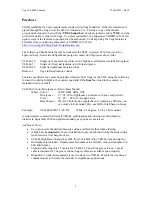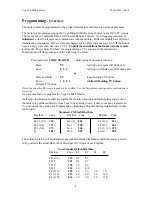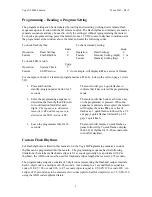
Vega VLB-44 Lantern
25 Jan 2011 - Rev 9
Programming Notes:
•
The lantern must be programmed with power applied in daytime conditions outside or in
a lighted room (fluorescent lighting may not allow proper programming).
•
Programming entries must not lag by more than 10 seconds or the lantern will exit the
programming mode. Write down the programming codes for each session to avoid
delays.
•
The Infrared Receiver (IR) is located in the base of the lantern through a window just
above the label. Aim the remote control here 6-12” from the lantern.
•
The lantern enters the programming mode by pressing the “red standby”, “power” or
“program” key on the remote for 5 seconds. The lantern will display 4 quick flashes (.1
sec on, 0.1 sec off) indicating that it is in the programming mode.
•
Each successful numeric keypad entry will result in 1 flash for each key pressed.
•
Wait for the lantern to flash before entering the next digit (don’t rush programming).
•
When the programming code is recognized, the lantern will display the 3 or 4 digit code
with a series of quick flashes with a gap of 0.5 seconds between each “number” of the
code. A zero (0) is displayed as a 2 second flash.
•
If the programming code is not recognized, the lantern will display 3 quick flashes and
the lantern will return to the programming mode (re-enter entire program code again).
•
When exiting programming mode, the lantern will display 2 quick flashes, followed by a
short pause and another 2 quick flashes, then display the flash rhythm for 16-20 seconds.
•
If the VLB-44 is the main light controlled by a SACII/III, the lantern must be
commanded on both day and night, and intensity set for both day and night. The daylight
control function is performed by the SACII/III and the lantern is controlled by power
being applied at dusk and secured at dawn by the SACII/III. If this is not done there is a
conflict between the daylight controls in the lantern and SACII/III. Setting the intensity
for both day and night is necessary to ensure that the light displays the correct intensity
during the transitions between night/day and day/night. See page 8 for specific
instructions.
Programming
Apply 12 VDC to the input leads of the lantern. Black or brown is positive and white or blue is
negative. The green/yellow sync wire is left disconnected. If you are using a power supply, be
sure that it is capable of providing enough power; approximately 1.25 amps per tier.
The lantern will power up in the default setting from the factory (or if it came pre-programmed).
After 10 seconds it will monitor the ambient light level and if bright enough will turn off (the
desired mode for programming). If, for some reason the voltage at the lantern is below 11.0
volts, the lantern will shut down to conserve energy and protect the battery and will not relight
unless power is reapplied or the voltage exceeds 13.0 volts and at least one daytime cycle is
detected (to prevent oscillation on and off at night).
The programming sequences are grouped together so that all codes are entered at one time. It is
suggested and acceptable to perform the programming operation in two separate sessions
(detailed
A
&
B
), however the code sequences can be entered sequentially after confirmation of
the code, but before the lantern exits the programming mode (within 10 seconds after the
confirmation flashes.) The two programming sequences required for most sessions are: flash
rhythm and intensity.
6




































